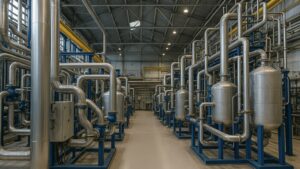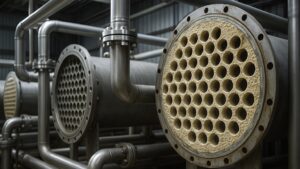The oil and gas industry is a major global contributor to greenhouse gas (GHG) emissions. It accounts for nearly a third of energy-related carbon dioxide emissions worldwide. Furthermore, pressure from global climate initiatives compels oil and gas companies to implement comprehensive Greenhouse gas accounting or monitoring, reporting, and reduction plans. Robust GHG inventories enable firms to benchmark performance. It also allows them to demonstrate accountability, meet compliance needs, and chart strategically. This is toward ambitious decarbonization goals.
This article outlines what are the methods of greenhouse gas accounting and innovative data collection technologies. We will also see some real-world best practices for emissions quantification in the carbon-intensive yet hard-to-abate oil and gas sector.
Importance of accurate greenhouse gas accounting
Oil and gas operations encompass a multitude of processes. It spans across exploration, production, processing, transportation, storage, and distribution facilities. Each stage represents potential linkages with multiple GHG emission sources. These include carbon dioxide, methane, nitrous oxide, etc. So, unless measured accurately, such distributed and fugitive emissions can be chronically underreported by firms. As a result, standardized methodologies for end-to-end Greenhouse gas accounting offer oil and gas companies the foundation. This is the foundation to manage their transition toward a low-carbon future.
Internationally, emission reporting frameworks by IPIECA, IOGP, and others guide voluntary public disclosures by upstream and downstream companies. Regionally, facilities operating under emissions-limiting schemes like the EU ETS require stringent monitoring. It also requires third-party verification of trade allowances.
Domestically too, regulations demand reasonable precision for operators functioning under carbon pricing systems. It also includes methane reduction programs across North America. So, beyond compliance, many integrated firms also make net zero pledges. This is to substantially curtail absolute emission levels by 2030 or 2050 against current baselines. Additionally, achieving such voluntary targets will need extensive visibility into GHG outputs across their operations.
Thus, through a combination of mandatory requirements and sustainability commitments, leading oil and gas firms increasingly focus on refining their greenhouse gas accounting accounting competencies. Moreover, the availability of consistent, quality-assured emissions data sets the stage for scientifically grounded reduction roadmaps.
Sources of key emissions
Oil and gas facilities represent a heterogeneous mix across exploration, production, midstream, and downstream segments:
Upstream assets
It is centered on locating underground oil and gas reservoirs via seismic surveys and exploratory drilling. Subsequently, efficient recovery through well drilling, hydrocarbon separation, and processing.
Key emission sources: venting, flaring, fugitive methane from equipment leaks, onsite fuel combustion, well testing/completions, and drilling rigs.
Midstream infrastructure
It connects upstream production to downstream facilities. This is via pipeline gathering systems, tank storage farms, rail/truck transport, and liquefied LNG infrastructure.
Key emission sources: compressor station fuel usage/venting, LNG liquefaction, trucking/marine fleets, and fugitive leaks.
Downstream assets
This focuses on converting crude oil and raw gas into end products. It includes petroleum fuels, lubricants, and petrochemical feedstocks. This is via diverse refining, cracking, and also reforming units.
Key emission sources: furnaces, boilers, catalytic crackers, and other conversion processes. Additionally, onsite power plants, wastewater treatment, and flare systems.
Each segment thus provides multiple avenues for GHG releases. It is usually a mix of carbon dioxide as well combustion combustion-generated methane and nitrous oxide emissions. So, building a composite inventory requires a nuanced categorization across hundreds of unit operations.
This is from high-emission equipment like dehydrators, separators to smaller blowdowns, and connectors. Moreover, data standardization and sharing between corporate siloes hence represents an underlying challenge. This challenge stands for end-to-end greenhouse gas accounting.
What are the methods of greenhouse gas accounting?
Among quantified estimates, a tiered hierarchy of measurement approaches provides the foundation for emissions data quality:
Tier 1 – direct monitoring
Continuous Emissions Monitoring Systems directly quantify stack gas streams. This is via infrared, chromatography, or other analyzers. Furthermore, it enables the highest accuracy but requires significant capex and opex investments. So, it is generally used at larger facilities or emission-intensive equipment. This includes crackers and reformers.
Tier 2 – Engineering Calculations
It is based on monitoring some primary parameters combined with standardized emissions factors. For example, a flare meter quantifies volumes. It gets multiplied by a conversion factor to derive estimated carbon dioxide emissions. So, it relies heavily on underlying data quality assumptions. Most commonly applied technique.
Tier 3 – Statistical Modeling
This has complex simulation models that codify statistical correlation. This is between available activity data and emission outputs. It can also assimilate a wider range of proxy variables cost-effectively. However, the accuracy is subject to model design limitations.
Tier 4 – Generalized Factors
Utilizes default technology/process/equipment-based emissions factors. This is often from published national inventories or industry associations. Furthermore, it has the lowest accuracy with high uncertainty levels but is easiest to implement.
Operators employ various methodologies. They are tailored to each site’s data infrastructure, operating context, and regulatory needs. However, higher-tier techniques provide better precision. This is essential for performance tracking and decision-making. Continual improvements in coverage, consistency, and completeness hence serve as the guiding objective when compiling corporation-wide emissions inventories.
Technology drivers enhancing accuracy
Advances in monitoring, quantification, and automation technologies also bolster the capabilities of oil and gas companies to refine greenhouse gas accounting approaches:
Continuous Methane Detection
Infrared cameras, aerial drones, and lower-cost sensors facilitate rapid detection of fugitive methane leaks. This is across exploration, production, and midstream facilities. Moreover, operators use such wide-area monitoring to quickly identify and rectify super-emitters.
Flow & Composition Measurement
It has built-in flow meters combined with gas chromatography to enable well pads. This is to continuously analyze volumes as well as the mix of high global warming potential (GWP) gases. It includes methane or CO2 getting vented/combusted.
Remote Sensing
Satellite platforms (eg. GHGSat) and aerial reconnaissance precisely quantify emission rates. This is from large point sources like flares associated with offshore platforms or gas plants. Cloud observation capabilities also minimize data gaps.
Blockchain Ledgers
Shared tamper-proof decentralized ledgers efficiently and securely track CO2 volumes. These are the ones associated with carbon dioxide-enhanced oil recovery operations or LNG cargo trades.
Data Consolidation
Cloud engineering tools compile emissions data enterprise-wide for integrated dashboards. Furthermore, machine learning reconciliations also deliver mass balance closure. This is between operations and corporate reporting boundaries.
While exploring relevant use cases, these technologies facilitate increased transparency plus third-party assurances around oil and gas emission profiles reported publicly by firms.
Best practices for corporate Greenhouse gas accounting
Fundamentally, the blueprint for repeatable and verifiable Greenhouse gas accounting relies on implementing robust standard operating procedures by oil and gas companies. These practices are the answer to how to reduce greenhouse gas emissions in the oil and gas industry:
Maintain oversight for quality assurance
A rigorous internal controls framework offers checks and balances. Statistical sampling also cost-efficiently verifies data integrity. Furthermore, independent internal audit teams bolster confidence.
Prioritize the highest emitting sources
20% of facilities often contribute 80%+ of volumes given disproportionate methane leaks or combustion emissions. So, fixing these enables significant reductions.
Establish data collection protocols
Standardized greenhouse gas accounting methodologies, monitoring routines, and documentation trains facilitate internal consolidation as well as external disclosures and assurance activities.
Focus on material disagreements during baseline establishes
Alignment between partners is essential for jointly owned ventures. This is right from initial quantification approaches to subsequent reduction plans. Contractual terms also need to reflect these.
Develop monitoring and analytics feedback loops
Continually identify anomalous emission trends across operations based on insights from high-frequency tracking. So, guide strategic mitigation initiatives.
Embrace transparency
Publicly report emissions via external registration schemes like The Climate Registry which enables credibility. It also progressively conforms with emerging regulations on measurement frequencies, detection limits, and reporting boundaries.
Maintain pace with disclosure frameworks
Benchmark corporate emissions accounting approaches against continually tightening industry association guidelines. It includes the OGMP 2.0 reporting standards.
While the blueprint principles remain consistent, practical interventions differ across the oil and gas value chain.
Real World Best Practices
Oil companies have taken clear leadership in GHG emissions monitoring, reporting, and verification practices given strong sustainability policy tailwinds like the EU Green Deal. So, benchmarking against regional industry peers fosters improved standards.
Shell
As one of Europe’s largest integrated energy firms, Shell has implemented several emissions quantification best practices:
● Deploys continuous methane sensing technologies like drones and infrared cameras. This is for rapid leak detection across assets from the Netherlands to Oman.
● Pioneered using AI to analyze images of flaring volumes captured at production sites. This is to minimize estimation uncertainties.
● Created the As One Reconciliation team that collates and assures GHG data flows from multiple business entities. It includes refineries, chemical plants, and service stations in over 70 countries into a single reporting boundary.
● Gets independent third-party verification of its entire GHG inventory on an annual basis by verification expert – Deloitte.
Equinor
Norway’s top petroleum producer also focuses on transparency:
● Developed an innovative digital offshore ranking dashboard. It provides asset-by-asset visibility into carbon intensity metrics for ranking. It also helps in continuously improving offshore oil fields.
● Is assessing emerging technologies like using satellites, sensors, and digital twins. This is to enable independent verification of methane emissions. This will also further strengthen inventory integrity.
Conclusion
The oil and gas industry is being closely watched. The reason tends to be its impact on the environment. It’s important for companies in this industry to accurately perform greenhouse gas accounting. This helps them set believable goals. It helps in reducing emissions and show that they are responsible. The process is tricky because of the complicated ways oil and gas are made/distributed. However, new technologies like using drones to detect methane are making it easier to keep an eye.
Still, it’s crucial for companies to follow good practices. It includes collecting data systematically, focusing on the biggest sources of emissions, and more. So, by using both new technologies and sticking to these good practices, oil and gas companies can create detailed lists of their emissions. This is an important first step in reducing their impact on the environment.
If you are focusing on your decarbonization or net zero goals, the global summit on net zero energy production is for you. The event in Amsterdam, Netherlands on 30th-31st January has over 100 industry leaders and over 20 hard-hitting insightful sessions. These sessions will range on topics like reducing on-site emissions, operationalizing sustainability, and more. It is also a great opportunity for networking and collaborating to reach your goals with the utmost profits. So, make sure you don’t miss the opportunity!





